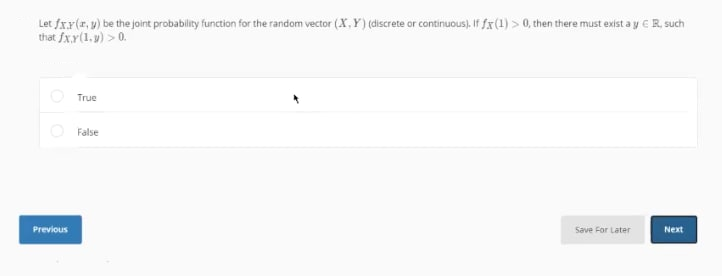Let fxr(r, y) be the joint probability function for the random vector (X, Y) (discrete or continuous). If fx(1) > 0, then there must exist a y CR, such that /x.r(1.p) > 0. True False
Let fxr(r, y) be the joint probability function for the random vector (X, Y) (discrete or continuous). If fx(1) > 0, then there must exist a y CR, such that /x.r(1.p) > 0. True False
Algebra & Trigonometry with Analytic Geometry
13th Edition
ISBN:9781133382119
Author:Swokowski
Publisher:Swokowski
Chapter10: Sequences, Series, And Probability
Section10.8: Probability
Problem 30E
Related questions
Question

Transcribed Image Text:Let fxr(r, p) be the joint probability function for the random vector (X, Y) (discrete or continuous). If fx(1) > 0, then there must exist a y eR. such
that fx.r(1.y) > 0.
True
O False
Previous
Save For Later
Next
Expert Solution
This question has been solved!
Explore an expertly crafted, step-by-step solution for a thorough understanding of key concepts.
This is a popular solution!
Trending now
This is a popular solution!
Step by step
Solved in 2 steps

Knowledge Booster
Learn more about
Need a deep-dive on the concept behind this application? Look no further. Learn more about this topic, statistics and related others by exploring similar questions and additional content below.Recommended textbooks for you

Algebra & Trigonometry with Analytic Geometry
Algebra
ISBN:
9781133382119
Author:
Swokowski
Publisher:
Cengage

College Algebra (MindTap Course List)
Algebra
ISBN:
9781305652231
Author:
R. David Gustafson, Jeff Hughes
Publisher:
Cengage Learning

Algebra & Trigonometry with Analytic Geometry
Algebra
ISBN:
9781133382119
Author:
Swokowski
Publisher:
Cengage

College Algebra (MindTap Course List)
Algebra
ISBN:
9781305652231
Author:
R. David Gustafson, Jeff Hughes
Publisher:
Cengage Learning